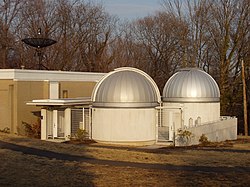
A refracting telescope is a type of optical telescope that uses a lens as its objective to form an image. The refracting telescope design was originally used in spyglasses and astronomical telescopes but is also used for long-focus camera lenses. Although large refracting telescopes were very popular in the second half of the 19th century, for most research purposes, the refracting telescope has been superseded by the reflecting telescope, which allows larger apertures. A refractor's magnification is calculated by dividing the focal length of the objective lens by that of the eyepiece.

Alvan Graham Clark was an American astronomer and telescope-maker.
Boyden Observatory is an astronomical research observatory and science education centre located in Maselspoort, 20 kilometres (12 mi) north-east of the city of Bloemfontein in Free State, South Africa. The observatory is managed by the Physics Department of the University of the Free State (UFS). The Friends of Boyden assist the observatory as a public support group, organising open evenings and protecting its public interest. Boyden also makes use of members of ASSA Bloemfontein Centre, the amateur astronomy club of the city, for presenters and telescope assistants.

Leiden Observatory is an astronomical institute of Leiden University, in the Netherlands. Established in 1633 to house the quadrant of Rudolph Snellius, it is the oldest operating university observatory in the world, with the only older still existing observatory being the Vatican Observatory.

The Pulkovo Astronomical Observatory, officially named the Central Astronomical Observatory of the Russian Academy of Sciences at Pulkovo, is the principal astronomical observatory of the Russian Academy of Sciences. It is located 19 km south of Saint Petersburg on Pulkovo Heights 75 metres (246 ft) above sea level. It is part of the UNESCO World Heritage Site Historic Centre of Saint Petersburg and Related Groups of Monuments. It was formerly known as the Imperial Observatory at Pulkowo.

The Cincinnati Observatory, known locally as Mt. Lookout Observatory, is located in Cincinnati, Ohio on top of Mount Lookout. It consists of two observatory buildings housing an 11-inch (28 cm) and 16 inch (41 cm) aperture refracting telescope. It is the oldest professional observatory in the United States. It was a key facility for astronomical research and education at the University of Cincinnati and currently operates as a 19th-century observatory. There are regular viewings through both historical telescopes as well as tours and additional programs. The observatory also has an extensive outreach program, providing astronomical education for the Ohio/Kentucky/Indiana region.

Armagh Observatory is an astronomical research institute in Armagh, Northern Ireland. Around 25 astronomers are based at the observatory, studying stellar astrophysics, the Sun, Solar System astronomy and Earth's climate.

The Leander McCormick Observatory is one of the astronomical observatories operated by the Department of Astronomy of the University of Virginia, and is situated just outside Charlottesville, Virginia (US) in Albemarle County on the summit of Mount Jefferson. It is named for Leander J. McCormick (1819–1900), who provided the funds for the telescope and observatory.
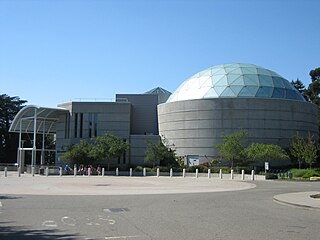
Chabot Space and Science Center, located in Oakland, California, is a center for science learning featuring interactive exhibits, planetariums, a large screen theater, hands-on activities and three powerful telescopes.
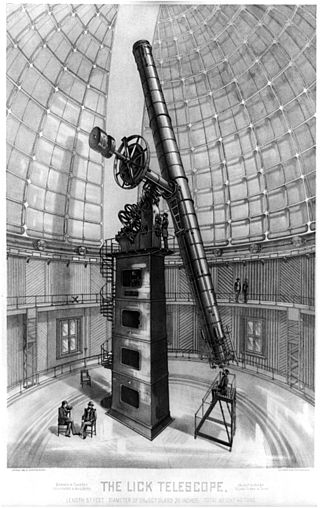
Alvan Clark & Sons was an American maker of optics that became famous for crafting lenses for some of the largest refracting telescopes of the 19th and early 20th centuries. Founded in 1846 in Cambridgeport, Massachusetts, by Alvan Clark, and his sons George Bassett Clark (1827–1891) and Alvan Graham Clark (1832–1897). Five times, the firm built the largest refracting telescopes in the world. The Clark firm gained "worldwide fame and distribution", wrote one author on astronomy in 1899.
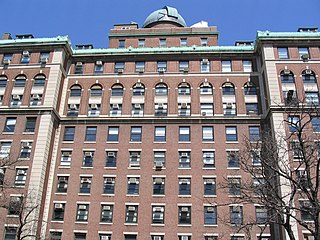
Rutherfurd Observatory is the astronomical facility maintained by Columbia University named after Lewis Morris Rutherfurd. Initially, Rutherfurd housed its telescopes and equipment in midtown Manhattan and later on the Stuyvesant Estate. When the Morningside campus was built, telescopes were kept in a "transit building" where the Interdisciplinary Science Building now stands. When Pupin Physics Laboratories were completed in 1927, the home of the observatory was moved to the top of the building. Below the Rutherfurd Observatory on the 14th floor was the site of Professor Wallace Eckert's Astronomical Laboratory, in which he constructed the first device to perform general scientific calculations automatically in 1933-34.

Michigan State University Observatory is an astronomical observatory owned and operated by Michigan State University. It is located south of the Michigan State University campus in East Lansing, Michigan (USA), near the corner of Forest Rd and College Rd. It has a Cassegrain telescope in its single dome. Built by Boller and Chivens, the Michigan State University telescope was commissioned in 1969 and entered regular operation in 1970. In 1974, what was at the time a state-of-the-art Raytheon Microcomputer was installed to function as a data gathering and control system. Originally, single channel photoelectric photometry and photography using plates or film were the means of acquiring data. The observatory was closed from 1981 until 1986, at a time when the university was having financial difficulties. It was reopened in the spring of 1986 on the occasion of the return of Comet Halley and has been in regular operation ever since. Since the 1980s, a CCD camera has been employed as the main instrument and the Raytheon computer has been retired. The International Astronomical Union has assigned the MSU Observatory identification code 766.

Mills Observatory is the first purpose-built public astronomical observatory in the UK, located in Dundee, Scotland. Built in 1935, the observatory is classically styled in sandstone and has a distinctive 7 m dome, which houses a Victorian refracting telescope, a small planetarium, and display areas. The dome is one of two made from papier-mâché to survive in the UK, the other being at the Godlee Observatory.

The Dearborn Observatory is an astronomical observatory located on the Evanston campus of Northwestern University. The observatory was originally constructed in 1888, through an agreement between the university and the Chicago Astronomical Society. In the summer of 1939, Dearborn Observatory had to be moved to make way for the construction of the Technological Institute.

Great refractor refers to a large telescope with a lens, usually the largest refractor at an observatory with an equatorial mount. The preeminence and success of this style in observational astronomy defines an era in modern telescopy in the 19th and early 20th century. Great refractors were large refracting telescopes using achromatic lenses. They were often the largest in the world, or largest in a region. Despite typical designs having smaller apertures than reflectors, great refractors offered a number of advantages and were popular for astronomy. It was also popular to exhibit large refractors at international exhibits, and examples of this include the Trophy Telescope at the 1851 Great Exhibition, and the Yerkes Great Refractor at the 1893 World's Fair in Chicago.
The Lamont–Hussey Observatory (LHO) was an astronomical observatory owned and operated by the University of Michigan (UM). It was located in the city of Bloemfontein, Free State, South Africa. Construction at the site began in 1927, and the facility was closed in 1972.
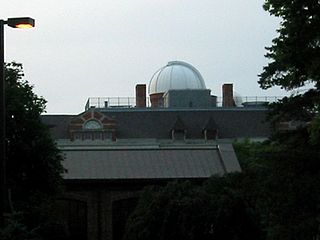
Sherzer Observatory is an astronomical observatory located on the campus of Eastern Michigan University. The observatory was established in 1903 with the construction of the new Natural Science Building, in Ypsilanti, Michigan. Following a devastating fire in 1989 a new observatory opened in September 1991 with a 10-inch (250 mm) apochromatic refractor telescope and German equatorial mount centered under a 6-meter dome.

The Royal Observatory, Cape of Good Hope, is a former scientific institution in South Africa. Founded by the British Board of Longitude in 1820, its main building is now the headquarters building of the South African Astronomical Observatory.

The Wilhelm Foerster Observatory in Berlin is a large public observatory which allows visitors to observe the sky through several telescopes. The facility is named after the German astronomer Wilhelm Foerster.
